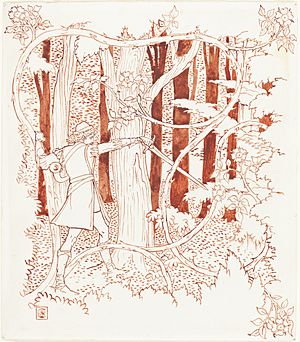Prince Charming facts for kids

Prince Charming is a fairy tale stock character who comes to the rescue of a damsel in distress and must engage in a quest to liberate her from an evil spell. This classification suits most heroes of a number of traditional folk tales, including "Snow White", "Sleeping Beauty", and "Cinderella", even if in the original story they were given another name, or no name at all.
Often handsome and romantic, these characters are essentially interchangeable, serving as a foil to the heroine; in many variants, they can be viewed as a metaphor for a reward the heroine achieves for the decisions she makes. The prominence of the character type makes him an obvious target for revisionist fairy tales. "Prince Charming" is also used as a term to refer to the idealized man some people dream of as a future spouse.
History of term

Charles Perrault's version of Sleeping Beauty, published in 1697, includes the following text at the point where the princess wakes up: "'Est-ce vous, mon prince?' lui dit-elle, 'vous vous êtes bien fait attendre'. Le Prince charmé de ces paroles... ne savait comment lui témoigner sa joie". ("'Are you my prince?' she said. 'You've kept me waiting a long time'. The prince charmed by her words... did not know how to express his joy.") It has sometimes been suggested that this passage later inspired the term, "Prince Charming", even though it is the prince who is charmed (charmé) here, not who is being charming (charmant). In the 17th century, Madame d'Aulnoy wrote two fairy tales, The Story of Pretty Goldilocks, where the hero was named Avenant ("Fine", "Beautiful", in French), and The Blue Bird, where the hero was Le roi Charmant ("The Charming King"). When Andrew Lang retold the first (in 1889) for The Blue Fairy Book, he rendered the hero's name as "Charming"; the second, for The Green Fairy Book, as "King Charming". Although neither one was a prince and the first was not royal, this may have been the original use of "Charming".
In the early Disney animated feature, Snow White and the Seven Dwarfs (1937), when Snow White tells the dwarfs about her prince, she says, "Anyone could see that the prince was charming, the only one for me." However, he is never referred to specifically as "Prince Charming". Andreas Deja initially struggled with the concept of animating a handsome villain in Beauty and the Beast. Deja ultimately based Gaston's appearance on those of handsome soap opera actors in order to create a grotesque version of the Prince Charming stock character.
In other languages, like Spanish and Italian, he is called the "Blue Prince". In Portuguese, a translation mistake occurred and he is called "Charmed Prince" (Príncipe Encantado; the correct term for "Charming" should be Encantador or Charmoso), coincidentally closer to the sense in Perrault's story mentioned atop this section.
See also
 In Spanish: Príncipe azul para niños
In Spanish: Príncipe azul para niños

